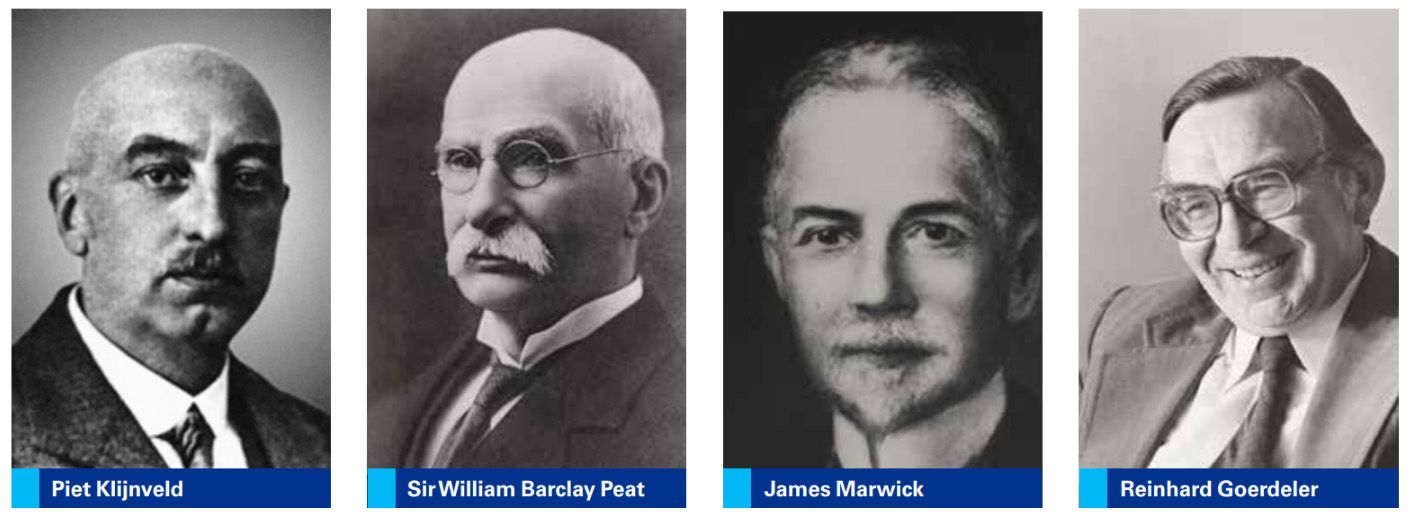Our history
The period from the late 19th century to the early 20th century, when the world's largest accounting firms were established with the Industrial Revolution, is called the "golden age of accounting." The pioneers who stood out during that time were the legendary entrepreneurs who laid the foundation for what would later become KPMG.

Piet Klynveld
Entrepreneur Piet Klynveld founded a small accounting firm in 1917 in Amsterdam, the Netherlands, a bustling trade and investment hub for European and Asian industrialists. During this period, numerous foreign enterprises, including royal families, governments, and even the Bank of England, engaged in extensive trade activities in the Netherlands, transforming the city into an active market not only for financiers but also for importers and exporters from nearly every sector.
Klynveld served as the chief accountant for many of these emerging businesses. To meet the growing demands of his increasing clientele, he partnered with a local tax firm, Meijburg & Company. Later, he recruited talented accountants to collaborate with companies that would eventually become leading enterprises in the Netherlands and globally.
One of those accountants was Jaap Kraayenhof, who joined Klynveld and ultimately became Senior Partner of the Dutch firm Klynveld Kraayenhof & Company (KKC).
Specializing in banking and exports, KKC maintained its name and independence while serving Dutch clients expanding into Europe and South America. In 1979, with the goal of creating a strong, Europe-based international company, Klynveld Main Goerdeler was established.
Sir William Barclay Peat
Sir William Barclay Peat, born in Scotland, was the second son of James Peat and Margaret Barclay, who came from the renowned banking family that founded Barclays Bank, one of the largest banks in England. Born into a privileged family, Peat studied law at the prestigious Montrose Academy in Scotland but did not pursue a legal career.
Instead, in 1870, at the age of 17, he moved to London to forge his own path. He was hired as an accounting clerk at a London firm and quickly climbed the ranks, becoming a partner at just 24. In 1891, Peat took over the leadership of the firm, renamed it WB Peat & Company, and laid the foundations for an accounting legacy that continues to this day.
Roger White, a retired KPMG Senior Partner and the unofficial company historian, authored the book Peats to KPMG—Gracious Family to Global Firm, published in the UK in 2004. He notes, “The Peat family retained the firm’s partnership under the condition that the senior partner must be a Peat for at least three generations.” To this day, the Peat name remains significant in the accounting world.
Sir William Peat’s great-grandson, Michael, worked at KPMG for five years and now serves as one of Prince Charles’s most trusted aides. Sir Michael Peat, an accountant educated at Eton and Oxford, has received widespread praise for his strict financial discipline at Buckingham Palace and his role as the Queen’s Treasurer.
James Marwick
James Marwick is described by Roger White as “a towering figure, standing two meters tall, with boundless energy and broad shoulders.” White adds, “My impression of this Scotsman is that he was a great man in every sense—his personality, presence, and ability to shape events.”
A trained chartered accountant, young Marwick had ambitions beyond accounting. He began his career in Glasgow but seized the opportunity to travel to Australia in the 1890s to conduct a bank audit for a Scottish investment group during a banking crisis.
With his energetic and passionate nature, Marwick set sail from Australia to Canada, though he was determined to return to Australia. However, he became so captivated by the growing banking sector and business opportunities in North America that in 1894, he decided to stay in the U.S. and began searching for a business partner.
According to White, Marwick had a chance encounter in 1897 on a street in New York City with his former Glasgow University classmate, Roger Mitchell. Mitchell had been sent to the U.S. to manage his family’s textile business. The two developed what was described as a perfect "front office/back office partnership."
After establishing Marwick, Mitchell & Company in New York, Marwick traveled extensively, opening offices across the U.S. Percy Garrett, who managed the London office, once wrote that the tireless Marwick covered 15,000 miles a year.
In 1911, Marwick and Mitchell joined forces with Sir William Barclay Peat to form Marwick, Mitchell, Peat & Company. However, eight years later, the partners split, and Marwick retired in 1917, passing leadership to Mitchell. Mitchell continued as Senior Partner until 1925, when he and Peat reunited, renaming the firm Peat, Marwick & Mitchell.
Reinhard Goerdeler
Reinhard Goerdeler was the son of Carl Goerdeler, who served as the mayor of Leipzig, Germany, from 1930 to 1937.
In 1953, Reinhard Goerdeler joined Deutsche Treuhand-Gesellschaft (DTG), a firm established by Deutsche Bank in 1890 to manage its clients' investments in American railroads. As the German economy recovered, Goerdeler began traveling across Europe, opening small offices for DTG and collaborating with firms like KKC to better serve international clients.
Believing that European clients needed a more structured international presence, Goerdeler started working toward the creation of a multinational firm in the 1970s.
In July 1979, an agreement was signed, leading to the formation of Klynveld Main Goerdeler (KMG). Goerdeler also played a key role in the landmark 1987 merger between KMG and Peat Marwick International, which was considered one of the first "mega mergers" of its kind.
Early Company Mergers
Peat and Mitchell met as travel companions while crossing the Atlantic Ocean from Europe to America in 1911. During the weeks-long journey, they had the opportunity to get to know each other, and by the end of the voyage, they had devised a plan to join forces. The firm later began operating under the name Peat, Marwick, Mitchell & Co.
Rapid Changes in the 1970s and 1980s
In 1978, Peat, Marwick, Mitchell & Co. (International) underwent a restructuring and rebranded as Peat Marwick International (PMI).
Meanwhile, Klynveld Kraayenhof & Co. was also focused on expansion. Just a year later, in 1979, it joined forces with Deutsche Treuhand-Gesellschaft (DTG) and McLintock Main Lafrentz to form Klynveld Main Goerdeler (KMG).
Less than a decade later, in 1986, PMI and KMG merged. When the merger was publicly announced on January 1, 1987, a new firm was born: Klynveld Peat Marwick Goerdeler (KPMG).
At the time, this merger was the largest in the history of the accounting industry, setting a new benchmark for global professional services firms.
Continuous Growth
In the 1990s and 2000s, KPMG continued to expand its network, venturing into emerging markets. In countries like Russia, India, and Myanmar, KPMG member firms contributed to economic development and the creation of new opportunities.
Today, the network of member firms spans 154 countries and consists of 197,000 employees. Each employee is committed to fostering growth in line with the organization's purpose, building trust, and driving change for clients, communities, and society as a whole.
Bize ulaşın
Connect with us
- Find office locations kpmg.findOfficeLocations
- kpmg.emailUs
- Social media @ KPMG kpmg.socialMedia


